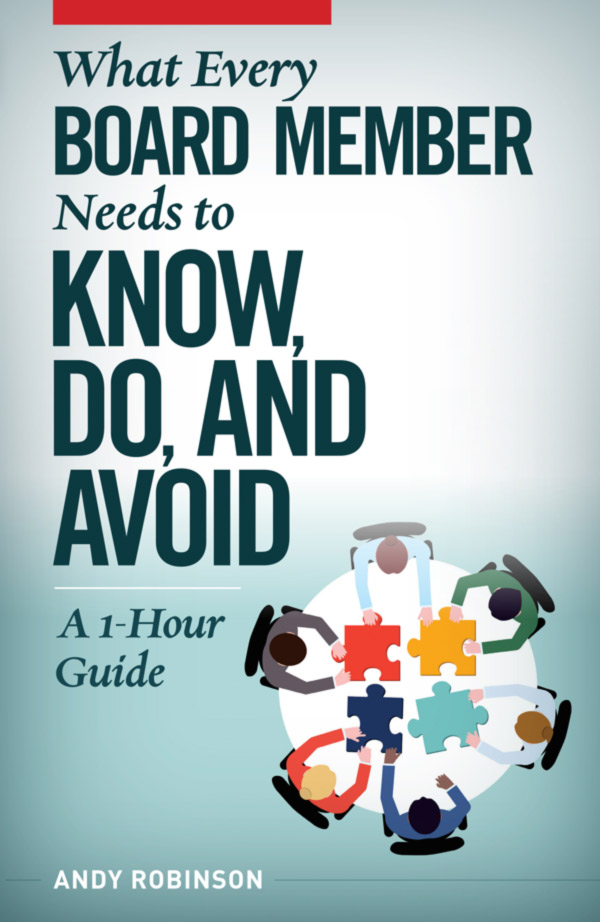 Imagine the following exercise.
Imagine the following exercise.
Gather your board members around a flip chart. Ask the following question:
“If we could design the perfect board for our group, what skills, qualities, and representation would we want in prospective board members?”
Skills, qualities, representation
Skills include specific expertise to help the board run effectively: program knowledge, marketing, fundraising, meeting facilitation, consensus-building, or appropriate professional wisdom. For example, accounting, community organizing, or investment knowledge.
Qualities would cover more intangible (but no less important) factors such as team player, a sense of humor, good listener, willingness to attend meetings, risk-taker, and experience on other boards.
Perhaps the most important quality is passion for, and commitment to, the nonprofit’s mission.
Representation: Who’s in the room? Does your board represent the community you serve?
This is an opportunity to discuss diversity in terms of race, social class, gender identity, age, geography, sexual orientation, etc.
Brainstorm the list with the full board. Senior staff can help, too. Think as broadly as possible. With a bit of effort, most groups can generate 20 or 25 items they would love to incorporate into their “best possible board.”
To assist, here’s a blank matrix you can use.
How are we doing? Three ways to find out
Having created this list, it’s natural to ask, “How does our current board compare to this idealized one? What are we doing well? Where do we need help?” At a more sophisticated level, you might ask, “How do we recruit a different mix of board members to fill the gaps we’ve just identified?”
Here are three ways to use this tool to evaluate your board.
Collectively. Review the list together and give yourselves a collective grade for each item. Here’s a simple scoring system:
(+) Outstanding
(√) Adequate
(-) Poor
(?) Don’t know
Self-evaluation. Ask board members to rate themselves against the criteria on the list, using the same scoring system. This exercise helps leaders think more creatively and comprehensively about what they bring (or don’t bring) to the board. As a result, it provides an opportunity to help improve or remove less-than-effective trustees.
 Member-by-member analysis. As a third option, ask the officers or the board development committee to fill in the blank matrix. Using this approach, the committee copies the brainstormed list down the left side of the form, adds the initials of board members across the top, and scores each trustee individually against these criteria.
Member-by-member analysis. As a third option, ask the officers or the board development committee to fill in the blank matrix. Using this approach, the committee copies the brainstormed list down the left side of the form, adds the initials of board members across the top, and scores each trustee individually against these criteria.
Here’s a partial sample; in practice, your list might be somewhat longer.
Skills, qualities, representation Board member initials
| LT | AL | RS | MI | AP | NT | GS | PR | SS | JJ | |
| Represents community served | – | – | + | – | + | √ | – | – | + | – |
| Has time to volunteer | – | ? | + | + | + | √ | – | + | ? | – |
| Will come to meetings | √ | ? | √ | + | √ | + | – | √ | – | √ |
| Program expertise | + | – | + | √ | – | √ | + | √ | ? | + |
| Team player | – | – | + | + | + | √ | √ | + | ? | + |
| Experience on other boards | + | + | √ | – | + | – | – | √ | + | √ |
| Fundraising skills | – | + | – | – | ? | – | + | √ | + | – |
| Meeting facilitation skills | + | ? | √ | √ | ? | √ | ? | √ | ? | + |
| Accounting/financial skills | + | + | – | – | √ | √ | √ | – | √ | √ |
Key: (+) Outstanding (√) Adequate (-) Poor (?) Don’t know
Once this work is completed, the committee would give the full board an overview of its findings, leaving individual scores anonymous. Committee members could also meet with individual trustees to show appreciation for the things they do well, while discussing ideas for addressing any weaknesses and increasing their participation.
This third approach makes some people nervous, because it allows one committee to judge the work of everyone. If this doesn’t feel right for your group, pick one of the other options.
 Do you really want a random board?
Do you really want a random board?
Build your board intentionally, recruiting the skills, qualities, and representation you need.
The alternative — “I know a guy…” — leads to a random board that generates random results.
This post is adapted from Andy’s latest book, What Every Board Member Should Know, Do, and Avoid, published by Emerson & Church.
Leave a Comment